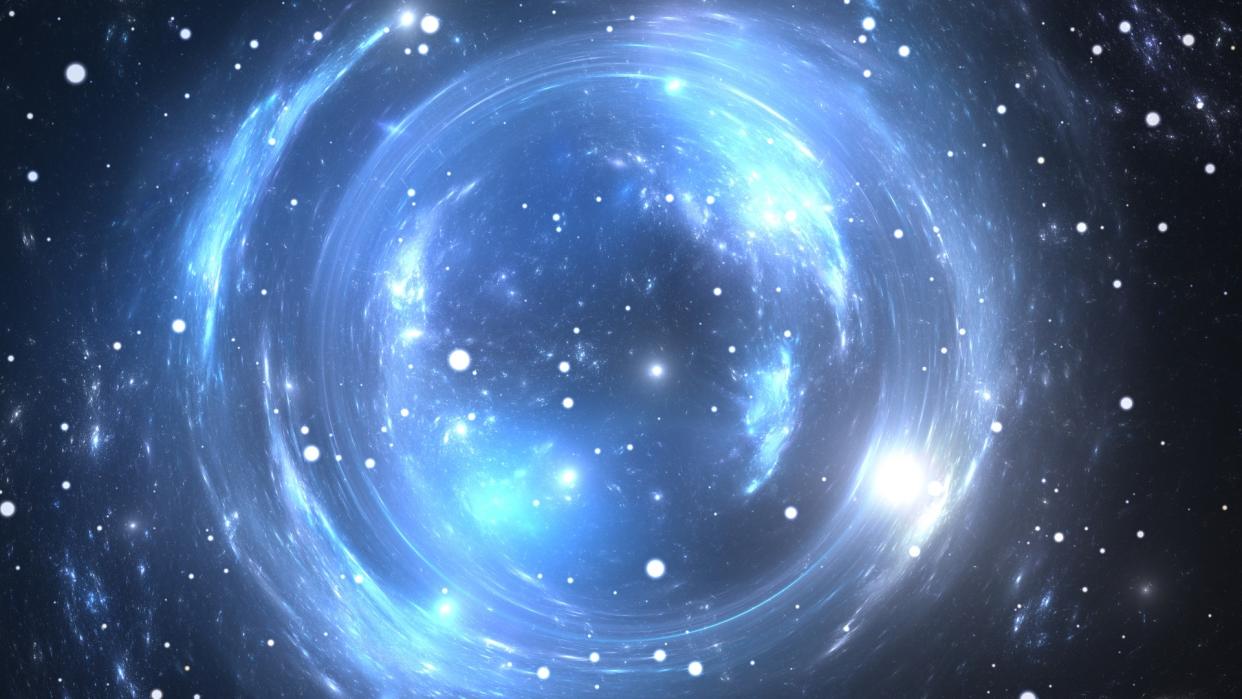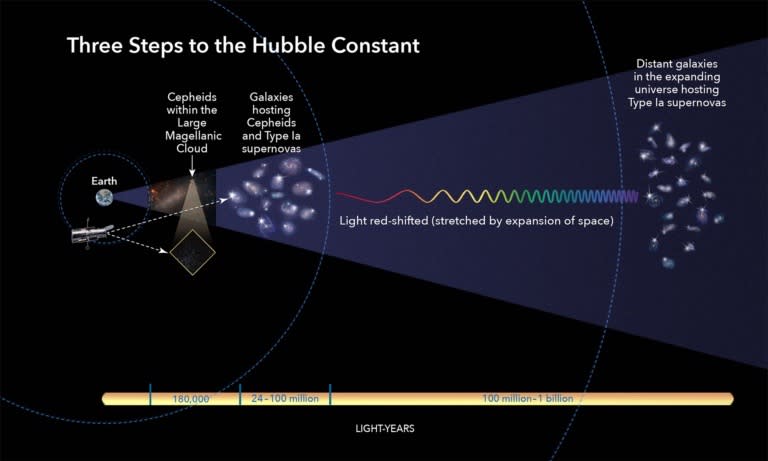'Cosmic magnifying glass' reveals super-rare warped supernova with gravitational lens. (Thanks, Einstein!)

The gravity of a distant galaxy warped space and magnified the light of a faraway supernova, potentially revealing tantalizing details about stellar explosions, as well as an unseen population of galaxies and the expansion of the universe.
The galaxy appears very faint to us and not particularly large, but its mass — a combination of its stars, gas and its invisible halo of dark matter — warps space into a gravitational lens, a sort of cosmic magnifying glass. As the light from the supernova passed by the galaxy, the lens magnified the light by as much as 25 times, and split the supernova into four images as the light took four different paths following the contours of the warped space.
The discovery is being called "exceptionally rare," and some of the scientists involved were surprised by it. That's because only a handful of gravitationally lensed supernovas have ever been discovered. "I was observing that night and was absolutely stunned when I saw the lensed image of SN Zwicky," said Caltech's Christoffer Fremling in a statement.
Related: A cosmic magnifying glass: What is gravitational lensing?
The supernova was a type Ia, meaning it was the destruction of a white dwarf star. It exploded over four billion light-years away and as its light journeyed towards us it encountered a galaxy in our line of sight, 2.5 billion light years away.
The supernova's light finally reached Earth on Aug. 21, 2022, where it was first spotted by Caltech's Zwicky Transient Facility (ZTF) at Palomar Observatory. Cataloged as SN 2022qmx, the supernova has also become known as 'SN Zwicky'.
The subsequent study of SN Zwicky was led by Ariel Goobar of Stockholm University in Sweden. Follow-up observations were performed by a host of telescopes, including the W. M. Keck Observatory, the Hubble Space Telescope, the Very Large Telescope, the Hobby-Eberly Telescope, the Liverpool Telescope and the Nordic Optical Telescope.
Intriguingly, the four images of the supernova warped by the gravitational lens were not all equal in brightness. Two of the images, designated A and C, were brighter than expected by more than four and two times, respectively. Goobar's team suggest that this could be caused by smaller 'microlensing' events within the lensing galaxy that further magnified the supernova's light.

Microlenses are smaller gravitational lenses created by individual stars or even planets, and in the case of SN Zwicky the additional microlensing effects could reveal clues as to the distribution of masses of stars in the core of the lensing galaxy. Astronomers suspect that conditions in the center of galaxies allow the formation of a larger number of massive stars than normal, and these massive stars would be the most likely candidates for the microlenses.
The lensed supernova will also provide a new and important data point in efforts to chart the expansion of the universe through measurements of its brightness and luminosity.
This is because type Ia supernovas explode with a standard brightness. We can compare their intrinsic luminosity with how bright they actually appear in our telescopes, and from that astronomers are able to figure out how far away they must be. From that they can make an estimation of how fast the universe is expanding and carrying the supernova away from us. Gravitational lenses extend this cosmic 'distance ladder' by allowing us to detect supernovas from farther away, and therefore testing the strength of dark energy — the force causing cosmic expansion to accelerate — in different epochs in the history of the universe.
"Not only is SN Zwicky magnified by the gravitational lens, but it also belongs to a class of supernova that we call 'standard candles' because we can use their well-known luminosities to determine distance in space," said Igor Andreoni of the University of Maryland, in a statement.
In some cases of lensed supernovas, it's also possible to use the time delay between the appearance of the multiple images to calculate the Hubble Constant, which is a value for the expansion rate of the universe. Recently, another lensed supernova discovered in 2014 known as SN Refsdal also displayed four images, but an additional fifth lensed image appeared a year later having taken a longer path through the warped space. By measuring how much the expanding universe had redshifted its light during that year's delay, astronomers were able to calculate the Hubble Constant as being between 64.8 and 66.6 kilometers per second per megaparsec of space. This value deepens the mystery of the so-called Hubble Tension, whereby different methods of measuring the Hubble Constant provide notably different values. To date, nobody knows why this.

Alas, SN Zwicky will not be able to help solve the Hubble Tension because the time delay between its four images — less than a few days — was too short to make a measurement of the Hubble Constant.
Yet another interesting aspect to all this is the lensing galaxy itself, which is rather faint and not particularly massive — it wouldn't have been noticed at all had the supernova not been so bright. Its existence suggests that it could represent another population of faint, modest galaxies billions of light years away that our sky surveys haven't really detected yet.
RELATED STORIES:
— Why do some James Webb Space Telescope images show warped and repeated galaxies?
— Supernova explosion's weird leftovers may contain a super-dense star
However, that might be about to change, as might the scarcity of lensed supernovas. The next few years will see the beginning of work by the Vera C. Rubin Observatory in Chile. Home to a survey telescope with a large 8.4-meter mirror, the Rubin Observatory is tasked with scanning the entire sky in high-resolution multiple times each night, searching for anything that goes bump in the dark, including lensed supernovas and their faint lensing galaxies.
"The discovery [of SN Zwicky] paves the way to find more rare lensed supernovas in future big surveys that will help us study transient astronomical events like supernovas and gamma-ray bursts," said Andreoni.
The study of SN Zwicky was published on 12 June 12 in Nature Astronomy.

